Konstantinos Psounis
University of Southern California
Preserving Privacy and Utility in LLM-Based Product Recommendations
May 02, 2025Abstract:Large Language Model (LLM)-based recommendation systems leverage powerful language models to generate personalized suggestions by processing user interactions and preferences. Unlike traditional recommendation systems that rely on structured data and collaborative filtering, LLM-based models process textual and contextual information, often using cloud-based infrastructure. This raises privacy concerns, as user data is transmitted to remote servers, increasing the risk of exposure and reducing control over personal information. To address this, we propose a hybrid privacy-preserving recommendation framework which separates sensitive from nonsensitive data and only shares the latter with the cloud to harness LLM-powered recommendations. To restore lost recommendations related to obfuscated sensitive data, we design a de-obfuscation module that reconstructs sensitive recommendations locally. Experiments on real-world e-commerce datasets show that our framework achieves almost the same recommendation utility with a system which shares all data with an LLM, while preserving privacy to a large extend. Compared to obfuscation-only techniques, our approach improves HR@10 scores and category distribution alignment, offering a better balance between privacy and recommendation quality. Furthermore, our method runs efficiently on consumer-grade hardware, making privacy-aware LLM-based recommendation systems practical for real-world use.
SpinML: Customized Synthetic Data Generation for Private Training of Specialized ML Models
Mar 05, 2025Abstract:Specialized machine learning (ML) models tailored to users needs and requests are increasingly being deployed on smart devices with cameras, to provide personalized intelligent services taking advantage of camera data. However, two primary challenges hinder the training of such models: the lack of publicly available labeled data suitable for specialized tasks and the inaccessibility of labeled private data due to concerns about user privacy. To address these challenges, we propose a novel system SpinML, where the server generates customized Synthetic image data to Privately traIN a specialized ML model tailored to the user request, with the usage of only a few sanitized reference images from the user. SpinML offers users fine-grained, object-level control over the reference images, which allows user to trade between the privacy and utility of the generated synthetic data according to their privacy preferences. Through experiments on three specialized model training tasks, we demonstrate that our proposed system can enhance the performance of specialized models without compromising users privacy preferences.
EEE-Bench: A Comprehensive Multimodal Electrical And Electronics Engineering Benchmark
Nov 03, 2024Abstract:Recent studies on large language models (LLMs) and large multimodal models (LMMs) have demonstrated promising skills in various domains including science and mathematics. However, their capability in more challenging and real-world related scenarios like engineering has not been systematically studied. To bridge this gap, we propose EEE-Bench, a multimodal benchmark aimed at assessing LMMs' capabilities in solving practical engineering tasks, using electrical and electronics engineering (EEE) as the testbed. Our benchmark consists of 2860 carefully curated problems spanning 10 essential subdomains such as analog circuits, control systems, etc. Compared to benchmarks in other domains, engineering problems are intrinsically 1) more visually complex and versatile and 2) less deterministic in solutions. Successful solutions to these problems often demand more-than-usual rigorous integration of visual and textual information as models need to understand intricate images like abstract circuits and system diagrams while taking professional instructions, making them excellent candidates for LMM evaluations. Alongside EEE-Bench, we provide extensive quantitative evaluations and fine-grained analysis of 17 widely-used open and closed-sourced LLMs and LMMs. Our results demonstrate notable deficiencies of current foundation models in EEE, with an average performance ranging from 19.48% to 46.78%. Finally, we reveal and explore a critical shortcoming in LMMs which we term laziness: the tendency to take shortcuts by relying on the text while overlooking the visual context when reasoning for technical image problems. In summary, we believe EEE-Bench not only reveals some noteworthy limitations of LMMs but also provides a valuable resource for advancing research on their application in practical engineering tasks, driving future improvements in their capability to handle complex, real-world scenarios.
Efficient Toxic Content Detection by Bootstrapping and Distilling Large Language Models
Dec 13, 2023Abstract:Toxic content detection is crucial for online services to remove inappropriate content that violates community standards. To automate the detection process, prior works have proposed varieties of machine learning (ML) approaches to train Language Models (LMs) for toxic content detection. However, both their accuracy and transferability across datasets are limited. Recently, Large Language Models (LLMs) have shown promise in toxic content detection due to their superior zero-shot and few-shot in-context learning ability as well as broad transferability on ML tasks. However, efficiently designing prompts for LLMs remains challenging. Moreover, the high run-time cost of LLMs may hinder their deployments in production. To address these challenges, in this work, we propose BD-LLM, a novel and efficient approach to Bootstrapping and Distilling LLMs for toxic content detection. Specifically, we design a novel prompting method named Decision-Tree-of-Thought (DToT) to bootstrap LLMs' detection performance and extract high-quality rationales. DToT can automatically select more fine-grained context to re-prompt LLMs when their responses lack confidence. Additionally, we use the rationales extracted via DToT to fine-tune student LMs. Our experimental results on various datasets demonstrate that DToT can improve the accuracy of LLMs by up to 4.6%. Furthermore, student LMs fine-tuned with rationales extracted via DToT outperform baselines on all datasets with up to 16.9\% accuracy improvement, while being more than 60x smaller than conventional LLMs. Finally, we observe that student LMs fine-tuned with rationales exhibit better cross-dataset transferability.
FireFly A Synthetic Dataset for Ember Detection in Wildfire
Aug 06, 2023Abstract:This paper presents "FireFly", a synthetic dataset for ember detection created using Unreal Engine 4 (UE4), designed to overcome the current lack of ember-specific training resources. To create the dataset, we present a tool that allows the automated generation of the synthetic labeled dataset with adjustable parameters, enabling data diversity from various environmental conditions, making the dataset both diverse and customizable based on user requirements. We generated a total of 19,273 frames that have been used to evaluate FireFly on four popular object detection models. Further to minimize human intervention, we leveraged a trained model to create a semi-automatic labeling process for real-life ember frames. Moreover, we demonstrated an up to 8.57% improvement in mean Average Precision (mAP) in real-world wildfire scenarios compared to models trained exclusively on a small real dataset.
How Much Privacy Does Federated Learning with Secure Aggregation Guarantee?
Aug 03, 2022



Abstract:Federated learning (FL) has attracted growing interest for enabling privacy-preserving machine learning on data stored at multiple users while avoiding moving the data off-device. However, while data never leaves users' devices, privacy still cannot be guaranteed since significant computations on users' training data are shared in the form of trained local models. These local models have recently been shown to pose a substantial privacy threat through different privacy attacks such as model inversion attacks. As a remedy, Secure Aggregation (SA) has been developed as a framework to preserve privacy in FL, by guaranteeing the server can only learn the global aggregated model update but not the individual model updates. While SA ensures no additional information is leaked about the individual model update beyond the aggregated model update, there are no formal guarantees on how much privacy FL with SA can actually offer; as information about the individual dataset can still potentially leak through the aggregated model computed at the server. In this work, we perform a first analysis of the formal privacy guarantees for FL with SA. Specifically, we use Mutual Information (MI) as a quantification metric and derive upper bounds on how much information about each user's dataset can leak through the aggregated model update. When using the FedSGD aggregation algorithm, our theoretical bounds show that the amount of privacy leakage reduces linearly with the number of users participating in FL with SA. To validate our theoretical bounds, we use an MI Neural Estimator to empirically evaluate the privacy leakage under different FL setups on both the MNIST and CIFAR10 datasets. Our experiments verify our theoretical bounds for FedSGD, which show a reduction in privacy leakage as the number of users and local batch size grow, and an increase in privacy leakage with the number of training rounds.
A Unified Prediction Framework for Signal Maps
Feb 12, 2022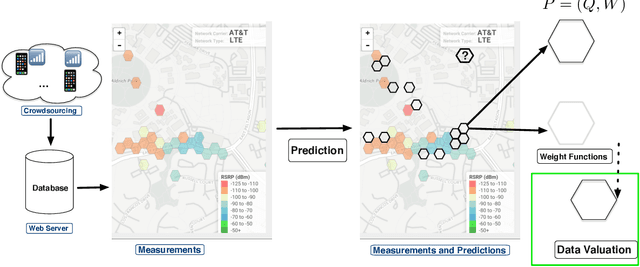
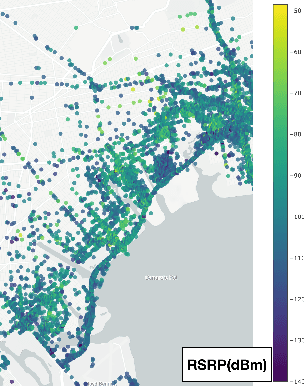
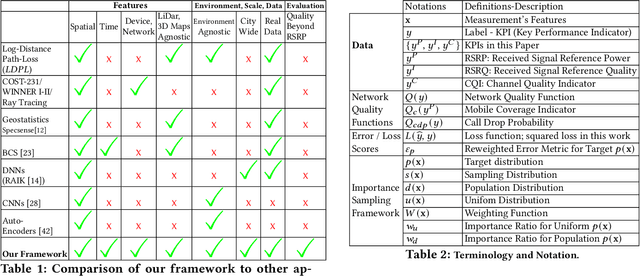
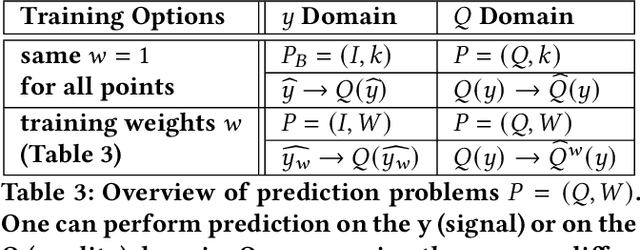
Abstract:Signal maps are essential for the planning and operation of cellular networks. However, the measurements needed to create such maps are expensive, often biased, not always reflecting the metrics of interest, and posing privacy risks. In this paper, we develop a unified framework for predicting cellular signal maps from limited measurements. Our framework builds on a state-of-the-art random-forest predictor, or any other base predictor. We propose and combine three mechanisms that deal with the fact that not all measurements are equally important for a particular prediction task. First, we design quality-of-service functions ($Q$), including signal strength (RSRP) but also other metrics of interest to operators, i.e., coverage and call drop probability. By implicitly altering the loss function employed in learning, quality functions can also improve prediction for RSRP itself where it matters (e.g., MSE reduction up to 27% in the low signal strength regime, where errors are critical). Second, we introduce weight functions ($W$) to specify the relative importance of prediction at different locations and other parts of the feature space. We propose re-weighting based on importance sampling to obtain unbiased estimators when the sampling and target distributions are different. This yields improvements up to 20% for targets based on spatially uniform loss or losses based on user population density. Third, we apply the Data Shapley framework for the first time in this context: to assign values ($\phi$) to individual measurement points, which capture the importance of their contribution to the prediction task. This improves prediction (e.g., from 64% to 94% in recall for coverage loss) by removing points with negative values, and can also enable data minimization. We evaluate our methods and demonstrate significant improvement in prediction performance, using several real-world datasets.
Privacy-Utility Trades in Crowdsourced Signal Map Obfuscation
Jan 13, 2022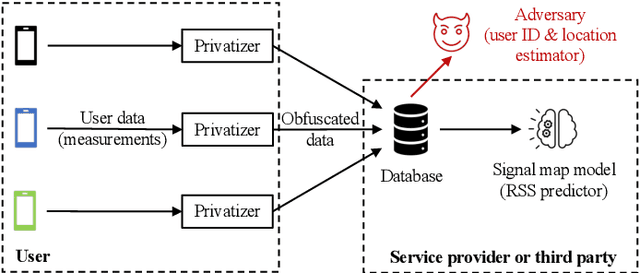

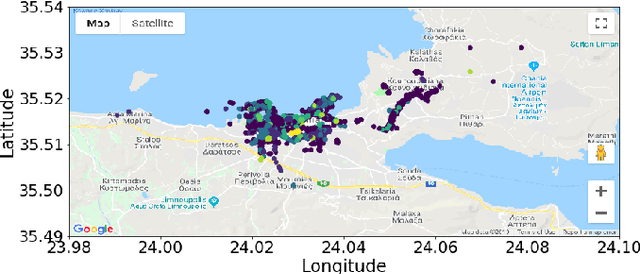

Abstract:Cellular providers and data aggregating companies crowdsource celluar signal strength measurements from user devices to generate signal maps, which can be used to improve network performance. Recognizing that this data collection may be at odds with growing awareness of privacy concerns, we consider obfuscating such data before the data leaves the mobile device. The goal is to increase privacy such that it is difficult to recover sensitive features from the obfuscated data (e.g. user ids and user whereabouts), while still allowing network providers to use the data for improving network services (i.e. create accurate signal maps). To examine this privacy-utility tradeoff, we identify privacy and utility metrics and threat models suited to signal strength measurements. We then obfuscate the measurements using several preeminent techniques, spanning differential privacy, generative adversarial privacy, and information-theoretic privacy techniques, in order to benchmark a variety of promising obfuscation approaches and provide guidance to real-world engineers who are tasked to build signal maps that protect privacy without hurting utility. Our evaluation results, based on multiple, diverse, real-world signal map datasets, demonstrate the feasibility of concurrently achieving adequate privacy and utility, with obfuscation strategies which use the structure and intended use of datasets in their design, and target average-case, rather than worst-case, guarantees.
Location Leakage in Federated Signal Maps
Dec 07, 2021
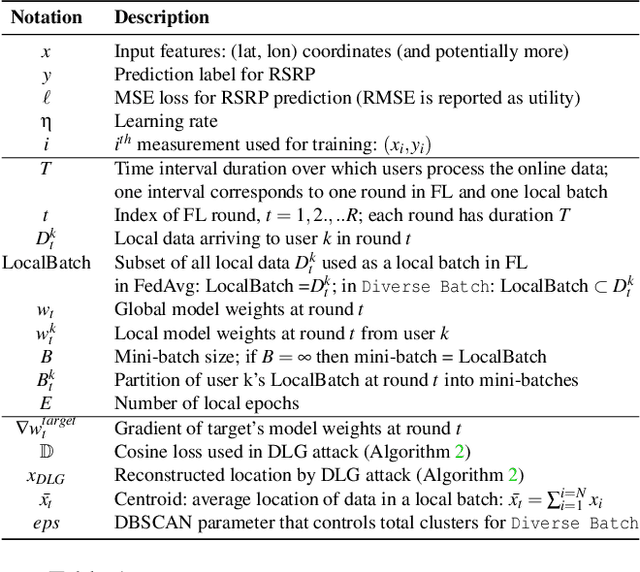


Abstract:We consider the problem of predicting cellular network performance (signal maps) from measurements collected by several mobile devices. We formulate the problem within the online federated learning framework: (i) federated learning (FL) enables users to collaboratively train a model, while keeping their training data on their devices; (ii) measurements are collected as users move around over time and are used for local training in an online fashion. We consider an honest-but-curious server, who observes the updates from target users participating in FL and infers their location using a deep leakage from gradients (DLG) type of attack, originally developed to reconstruct training data of DNN image classifiers. We make the key observation that a DLG attack, applied to our setting, infers the average location of a batch of local data, and can thus be used to reconstruct the target users' trajectory at a coarse granularity. We show that a moderate level of privacy protection is already offered by the averaging of gradients, which is inherent to Federated Averaging. Furthermore, we propose an algorithm that devices can apply locally to curate the batches used for local updates, so as to effectively protect their location privacy without hurting utility. Finally, we show that the effect of multiple users participating in FL depends on the similarity of their trajectories. To the best of our knowledge, this is the first study of DLG attacks in the setting of FL from crowdsourced spatio-temporal data.
HARPO: Learning to Subvert Online Behavioral Advertising
Nov 24, 2021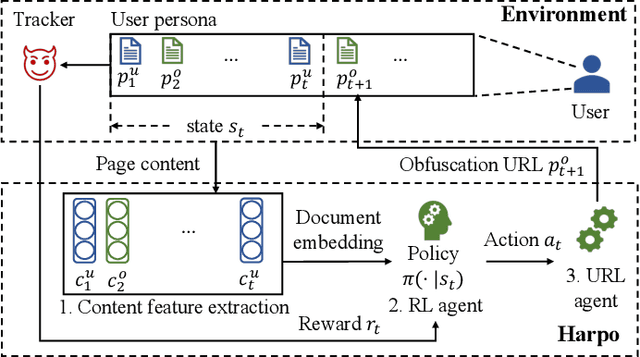

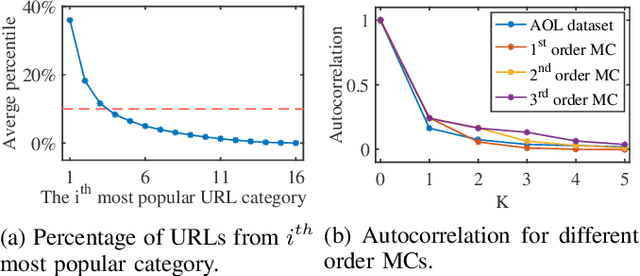

Abstract:Online behavioral advertising, and the associated tracking paraphernalia, poses a real privacy threat. Unfortunately, existing privacy-enhancing tools are not always effective against online advertising and tracking. We propose Harpo, a principled learning-based approach to subvert online behavioral advertising through obfuscation. Harpo uses reinforcement learning to adaptively interleave real page visits with fake pages to distort a tracker's view of a user's browsing profile. We evaluate Harpo against real-world user profiling and ad targeting models used for online behavioral advertising. The results show that Harpo improves privacy by triggering more than 40% incorrect interest segments and 6x higher bid values. Harpo outperforms existing obfuscation tools by as much as 16x for the same overhead. Harpo is also able to achieve better stealthiness to adversarial detection than existing obfuscation tools. Harpo meaningfully advances the state-of-the-art in leveraging obfuscation to subvert online behavioral advertising
 Add to Chrome
Add to Chrome Add to Firefox
Add to Firefox Add to Edge
Add to Edge